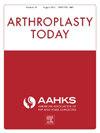接受阿哌沙班预防血栓形成治疗的全关节置换术患者围手术期应考虑使用氨甲环酸
IF 1.5
Q3 ORTHOPEDICS
引用次数: 0
摘要
背景本研究旨在探讨接受阿哌沙班血栓预防治疗的全关节置换术(TJA)患者围手术期服用氨甲环酸(TXA)能否降低术后出血风险,同时不增加血栓栓塞事件的发生率。方法利用Premier医疗保健数据库识别所有初级择期全膝关节置换术(TKA)和全髋关节置换术(THA)患者。将在住院期间接受阿哌沙班治疗并在手术当天接受TXA治疗的患者与未接受TXA治疗的患者进行比较。评估了各组之间在人口统计学、医院特征和合并症方面的差异。结果共确定了118219例TJA患者(TKA:65.3%;THA:34.7%),其中30592例(25.9%)仅接受了阿哌沙班,87627例(74.1%)接受了阿哌沙班和TXA。多变量分析发现,接受阿哌沙班和TXA治疗的患者发生出血并发症的风险降低(调整赔率[aOR]0.83,95%置信区间[CI]:0.81-0.86,P<0.05):0.81-0.86, P < .001)、输血(aOR 0.47, 95% CI: 0.43-0.52, P < .001)、急性贫血(aOR 0.84, 95% CI: 0.81-0.87, P < .001)、深静脉血栓(aOR 0.74,95% CI:0.66-0.83,P < .001)和肺栓塞(aOR 0.84,95% CI:0.72-0.96,P = .012)。结论接受阿哌沙班治疗的 TJA 患者围手术期使用 TXA 可降低出血并发症的风险,而不会增加血栓栓塞风险。关节置换外科医生应积极考虑为接受阿哌沙班治疗的 TJA 患者提供 TXA。本文章由计算机程序翻译,如有差异,请以英文原文为准。
Perioperative Tranexamic Acid Should Be Considered for Total Joint Arthroplasty Patients Receiving Apixaban for Thromboprophylaxis
Background
This study aims to investigate if the perioperative administration of tranexamic acid (TXA) for total joint arthroplasty (TJA) patients receiving apixaban for thromboprophylaxis can reduce the risk of postoperative bleeding without increasing the rate of thromboembolic events.
Methods
The Premier Healthcare Database was utilized to identify all primary elective total knee arthroplasty (TKA) and total hip arthroplasty (THA) patients. Patients receiving apixaban during their in-hospital admission who received TXA on the day of surgery were compared to those who did not receive TXA. Differences in demographics, hospital characteristics, and comorbidities were assessed between groups. Univariate and multivariable regressions were utilized to assess differences in 90-day bleeding, thromboembolic, and medical postoperative outcomes between cohorts.
Results
In total, 118,219 TJA patients were identified (TKA: 65.3%; THA: 34.7%), of which 30,592 (25.9%) received apixaban alone, and 87,627 (74.1%) received apixaban and TXA. Multivariable analyses found that patients who received apixaban and TXA had a reduced risk of aggregate bleeding complications (adjusted odds ratio [aOR] 0.83, 95% confidence interval [CI]: 0.81-0.86, P < .001), transfusion (aOR 0.47, 95% CI: 0.43-0.52, P < .001), acute anemia (aOR 0.84, 95% CI: 0.81-0.87, P < .001), deep vein thrombosis (aOR 0.74, 95% CI: 0.66-0.83, P < .001), and pulmonary embolism (aOR 0.84, 95% CI: 0.72-0.96, P = .012). No differences between cohorts were observed for risk of stroke (aOR 1.09, 95% CI: 0.82-1.46, P = .372) and myocardial infarction (aOR 0.94, 95% CI: 0.76-1.16, P = .564).
Conclusions
Perioperative administration of TXA to TJA patients receiving apixaban reduces the risk of bleeding complications without increasing thromboembolic risk. Arthroplasty surgeons should strongly consider providing TXA to TJA patients receiving apixaban.
求助全文
通过发布文献求助,成功后即可免费获取论文全文。
去求助
来源期刊

Arthroplasty Today
Medicine-Surgery
CiteScore
2.90
自引率
0.00%
发文量
258
审稿时长
40 weeks
期刊介绍:
Arthroplasty Today is a companion journal to the Journal of Arthroplasty. The journal Arthroplasty Today brings together the clinical and scientific foundations for joint replacement of the hip and knee in an open-access, online format. Arthroplasty Today solicits manuscripts of the highest quality from all areas of scientific endeavor that relate to joint replacement or the treatment of its complications, including those dealing with patient outcomes, economic and policy issues, prosthetic design, biomechanics, biomaterials, and biologic response to arthroplasty. The journal focuses on case reports. It is the purpose of Arthroplasty Today to present material to practicing orthopaedic surgeons that will keep them abreast of developments in the field, prove useful in the care of patients, and aid in understanding the scientific foundation of this subspecialty area of joint replacement. The international members of the Editorial Board provide a worldwide perspective for the journal''s area of interest. Their participation ensures that each issue of Arthroplasty Today provides the reader with timely, peer-reviewed articles of the highest quality.
 求助内容:
求助内容: 应助结果提醒方式:
应助结果提醒方式:


